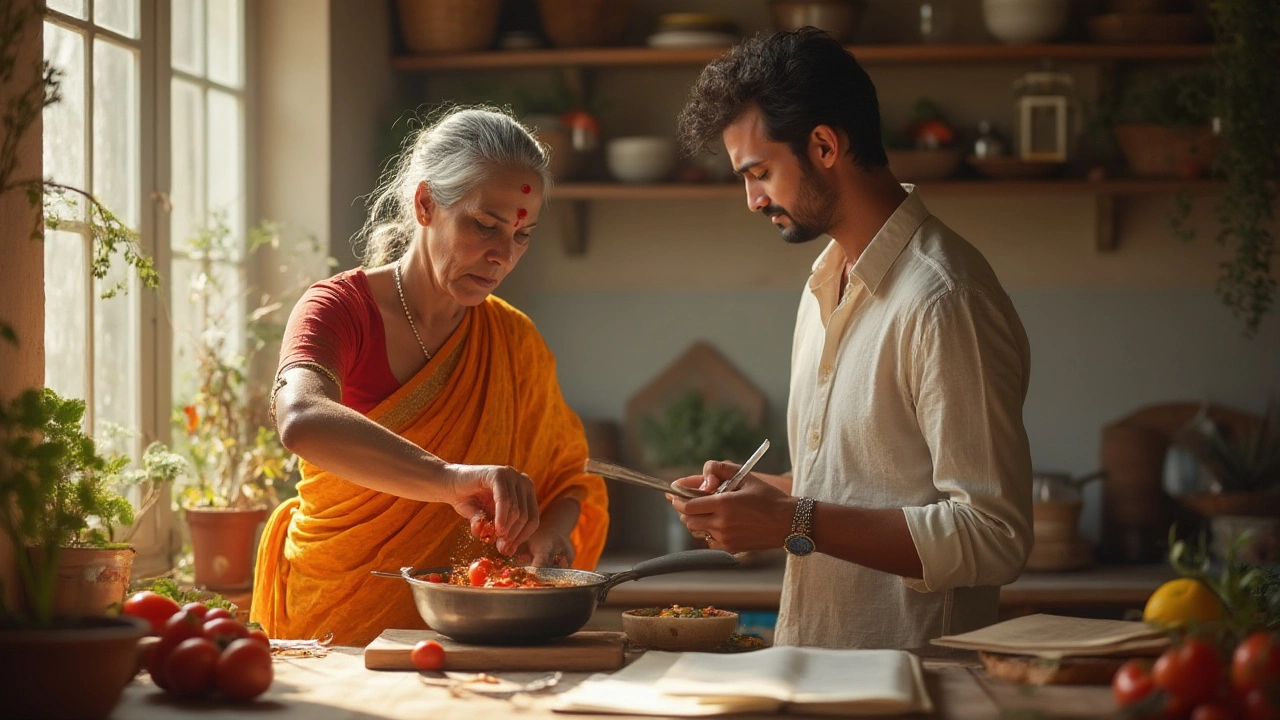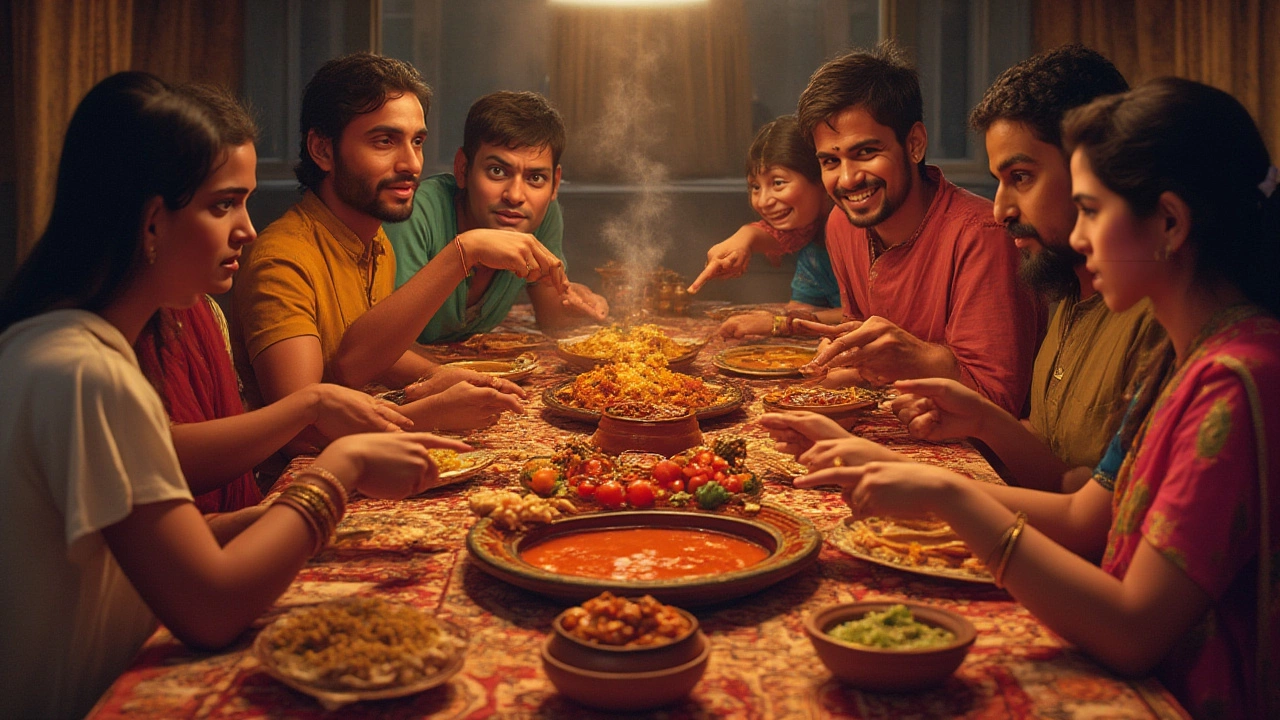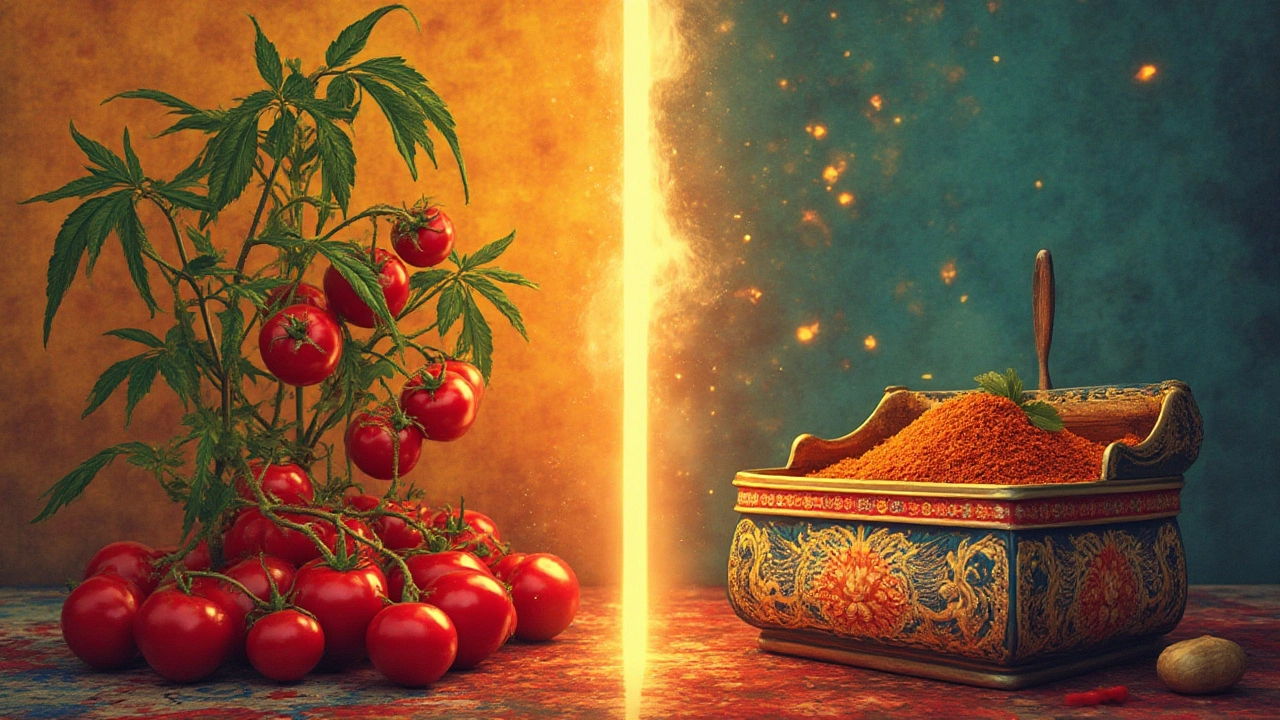Do Tomatoes Belong in Curry? The Truth About Tomatoes in Indian Recipes
 Jul, 15 2025
Jul, 15 2025
If you ever talk to Indian home cooks about curry, one debate will get everyone fired up—should you put tomatoes in curry or not? You might think it’s a no-brainer; open any internet recipe, and you’ll find tomatoes listed right after onions. But wander into an old-school kitchen in Punjab or stand beside a grandmother in Tamil Nadu, and you might get a stern look for even mentioning them. Tomatoes are almost everywhere today, from butter chicken to aloo curry, but it wasn’t always like this. Tomatoes only took their place in Indian food a few hundred years ago. They’re not native—Portuguese traders brought these bright red fruits to Indian shores around the 16th century. The idea of a 'classic curry' with tomatoes? It’s modern, shaped by trade, changing tastes, and some clever home economics. So, do tomatoes really belong in curry, or have we just gotten used to them? Strap in—this is going to get tasty.
The Origins: How Tomatoes Entered Indian Kitchens
This bit is wild. Tomatoes are as Indian as the potato or the chili—as in, not Indian at all before the 1500s. Both chilies and tomatoes found their way to India from the Americas, thanks to Portuguese traders. Before their arrival, curries looked and tasted pretty different. Back then, the main souring agents were things like tamarind, dried mango powder (amchur), yogurt, or even kokum (a coastal favorite). So, recipes like dal tadka or Punjabi kadhi, now so familiar with a splash of red, were made without any tomatoes for centuries.
Why did tomatoes catch on so fast? For starters, they’re cheap, pretty easy to grow in the Indian climate, and deliver that perfect mix of sweet-tang that brightens both vegetarian and meat dishes. After independence, as fresh produce availability improved and recipes started appearing in print (like in Tarla Dalal's famous cookbooks), tomatoes became the ingredient of convenience. A 2019 survey by the Indian Culinary Federation found that over 80% of urban North Indian households routinely use tomatoes in gravies. That doesn’t mean it’s universal—many South Indian recipes still shy away from tomatoes, sticking to tart tamarind or sour curd. Even today, if you ask five grandmothers for their curry recipe, you’ll get five very different answers…it all comes down to tradition, geography, and, honestly, what’s sitting in the fridge.
| Region | Common Curry Souring Ingredient | Tomato Usage (Traditional Recipes) |
|---|---|---|
| North India | Tomato, yogurt | Common since the 20th century |
| South India | Tamarind, kokum | Rare (except for some Chettinad dishes) |
| Bengal | Yogurt, mango, mustard | Optional, not core |
| Mumbai/Western India | Kokum, lime, tomato | Increasing since 1960s |
Here’s the cool part: some of the most famous 'classics'—think rogan josh, dhansak, or kadhi—didn’t use tomatoes originally. The shift really took off in the post-independence era, when cooks wanted bolder flavors, brighter gravies, and longer shelf life. The proof? Dig into Urdu cookbooks from the 19th century and good luck finding a single tomato in their curry sections! You’d much sooner see recipes for 'korma' or 'qaliya' built around yogurt, nuts, or just spice and slow cooking.

The Case For Tomatoes: Texture, Tang, and Color
Why do so many modern curries feature tomatoes front and center? Let’s break down what tomatoes actually bring to the table—and see if they’re worth the hype.
Tomatoes change everything about the texture of a curry. Spices get a smoother blend, onion-tomato bases give that silky, slightly thick gravy we all expect in restaurant-style curries. Steam escapes through tomatoes faster, which means curries cook a little quicker and tend to soak up spice flavors better. They also have something magic: umami, that deep, savory note you taste in dishes like dal makhani or paneer butter masala. This umami boost makes every other spice shine—a reason why so many Indian eateries rely on tomato purée or ketchup in their "secret sauces."
The bright red color is another crowd-pleaser. Let’s be honest, we eat first with our eyes. When people see a curry with that deep brick-red color (think chicken tikka masala), they reach for the ladle faster. Compare that to older curries—browner, paler, but often with a more complex flavor. The tomato’s tang balances out rich or oily flavors. Cooks managing heavy ingredients—like cream, coconut, or butter—use tomatoes as a counterpoint. A study by the Indian Institute of Food Processing Tech found that adding tomatoes reduced the perceived fattiness in paneer curries by 30%.
If you’re cooking on a budget or running a busy kitchen, tomatoes are your best friend. Fresh tomatoes stretch a sauce for a crowd, boost vitamin C, and help dishes last a little longer (the acidity keeps things fresh). For anyone who likes meal-prepping, tomato-based gravies don’t separate as easily as plain yogurt ones. The vitamin C and lycopene in cooked tomatoes are no joke—there are actual health benefits here. According to the National Institute of Nutrition, Hyderabad, cooked tomatoes offer more bioavailable lycopene—a powerful antioxidant—than raw ones. That means your go-to tomato curry can help with everything from skin health to reducing heart disease risk.
- Tip: If your curry feels too acidic, add a pinch of sugar or honey to balance it out. Tomato gravies can go from zesty to harsh if over-reduced.
- Want more depth? Use both fresh tomatoes and tomato paste. The paste brings intensity, but fresh tomatoes provide a gentle tang.
- If you’re out of tomatoes, try a bit of yogurt or tamarind for acidity—or a handful of roasted red bell peppers for sweet color. Cook what you love, don’t get caught up in tradition!

Should You Use Tomatoes in Curry—Or Skip Them?
This is where the battle gets intense. Purists will tell you that true Indian curry—whatever that means, given there are thousands of versions—doesn’t need tomatoes. They argue that using tomato turns every curry into a generic red sauce, masking the subtle interplay of spices, roasted onions, and other souring agents. Take a classic Kashmiri rogan josh: the original recipe relies on yogurt for richness and color from ground Kashmiri chili, not a single red tomato in sight. Or check out a proper Gujarati dal—it's famed for its sweet, tangy balance, thanks entirely to jaggery and kokum, not tomatoes.
Yet, there’s no denying that the tomato is here to stay in Indian kitchens. Find street vendors in Delhi, and nine out of ten times, the gravy bubbling in their massive tawas will start with onion and tomato. Ask them why, and you’ll usually get a practical answer: it’s affordable, cooks fast, and people expect it—especially at weddings or in restaurant settings where the sauce is king. One Ahmedabad chef told me, 'If I skip tomato, people complain the color is dull, even if the taste is perfect.' Today’s Indian palate is trained to look for that signature red sauce—so much so that food companies sell packets of 'curry gravy base' built around pureed tomato, onion, and ginger garlic.
Should you skip tomatoes just for the sake of tradition? If you’re after pure regional authenticity and you’ve got all the time in the world, sure! Your dal might taste a bit more complex, and your rogan josh a little silkier. Don’t forget, though: Indian food is about adaptability. Street food culture, migration, and global travel have all warped tradition in tasty ways. Modern recipes aren’t “less Indian”—they’re simply the current stop of a much longer culinary journey. The best advice? Know why you’re using an ingredient. Tomatoes can elevate a dish, but they’re not a crutch. Blindly dumping in tomatoes can drown gentle flavors like curry leaves, fenugreek, or black cardamom. But when used right, tomatoes give curry backbone, personality, and color people expect.
- Test it for yourself: Cook a basic curry base with and without tomato. Compare the flavor, tang, and color—it’s the easiest way to find your best combo.
- Looking for that old school flavor? Try subbing out tomatoes for amchur (dried mango powder), yogurt, or a dash of tamarind. You’ll find the sourness less punchy but more complex.
- When in doubt, start with fewer tomatoes and add more if needed. Once they’re in, you can’t go back.
The bottom line: Tomatoes don’t make or break a curry, but they’ve certainly left their stain on the map of Indian flavors. The secret is understanding what each ingredient does—not blindly following a recipe. So next time you stand at the chopping board, ask yourself: Does your curry recipe really need tomatoes? You’re the boss of your flavors—make them count.